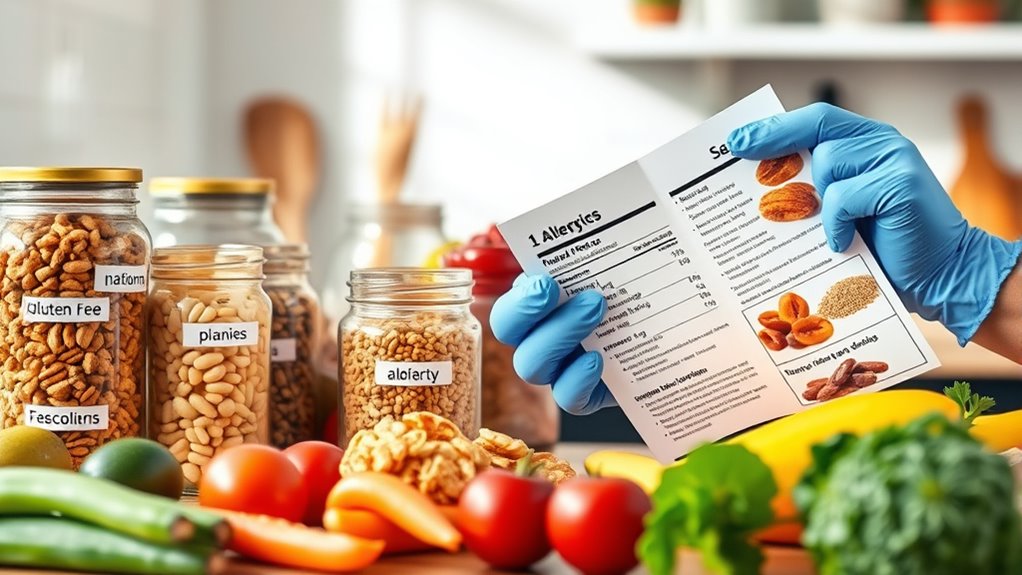Food allergies happen when your immune system mistakenly sees certain foods as threats, causing reactions like hives, swelling, or even breathing difficulties. Common allergens include nuts, dairy, eggs, wheat, soy, fish, and shellfish. To manage them, always read labels, carry an epinephrine auto-injector, and inform others about your allergies. Understanding symptoms and proper prevention can keep you safe. If you want to learn more about controlling and living with food allergies, keep exploring the essential tips.
Key Takeaways
- Recognize common food allergens and their symptoms to identify allergic reactions early.
- Carry an epinephrine auto-injector and know how to use it for emergencies like anaphylaxis.
- Read food labels carefully and communicate dietary restrictions when dining out to prevent accidental exposure.
- Work with healthcare professionals for testing, guidance, and creating a personalized allergy management plan.
- Educate family and caregivers about allergy signs and safety measures to ensure proper response and support.

Have you ever wondered what causes food allergies and how they affect millions of people worldwide? Food allergies happen when your immune system mistakenly identifies certain foods as threats. Instead of harmless substances, your body sees them as dangerous invaders and launches an attack. This immune response releases chemicals like histamines, which cause allergy symptoms.
Food allergies occur when the immune system mistakenly attacks certain foods, releasing chemicals that cause allergy symptoms.
The most common food allergens include peanuts, tree nuts, milk, eggs, wheat, soy, fish, and shellfish. These foods can trigger reactions that range from mild discomfort to severe, life-threatening emergencies.
When you consume an allergenic food, your symptoms might appear quickly, often within minutes. You might notice itching or swelling in your mouth, lips, or throat, making it hard to swallow or breathe. Skin reactions like hives or eczema can develop, accompanied by stomach discomfort, nausea, vomiting, or diarrhea.
In some cases, the allergy can cause respiratory issues such as wheezing or nasal congestion. For some, the reaction can escalate rapidly into anaphylaxis, a severe allergic response that requires immediate medical attention. It’s vital to recognize the signs early and seek emergency help if needed.
Managing food allergies requires vigilance and proactive strategies. Start by reading food labels carefully; manufacturers are required to list common allergens clearly. Be cautious when dining out—always inform your server about your allergies and ask about ingredients and preparation methods.
Carry an epinephrine auto-injector if your doctor prescribes one, and make sure you know how to use it properly. Educate yourself about cross-contamination risks, as even tiny traces of an allergen can trigger a reaction. Keep emergency contact information accessible at all times and consider wearing a medical alert bracelet indicating your allergies.
Developing a thorough allergy management plan involves more than avoiding trigger foods. It’s wise to work with a healthcare professional, such as an allergist, who can conduct testing and guide you on how to minimize risks. You might need to find suitable substitutes for your favorite foods to maintain a balanced diet.
Additionally, learn to recognize early warning signs of an allergic reaction and establish clear steps to take if symptoms appear. Educating family, friends, and caregivers about your allergies is essential, especially for children, to ensure they understand the importance of avoiding certain foods and acting swiftly during emergencies.
Living with food allergies can be challenging, but with proper knowledge and preparation, you can confidently manage your condition. Staying alert, informed, and prepared helps you avoid dangerous reactions and enjoy a safer, healthier life. Understanding cookie categories is also important for online safety and privacy management.
Frequently Asked Questions
Can Food Allergies Develop Later in Life?
You might wonder if food allergies can develop later in life. The answer is yes; although many allergies start in childhood, adults can develop new food allergies too.
Factors like changes in your immune system, exposure to new foods, or health conditions can trigger this.
Are Food Allergies Hereditary or Genetic?
You might wonder if food allergies are hereditary or genetic. While your genes can influence your likelihood, they don’t guarantee you’ll develop allergies.
If a family member has allergies, you’re more prone to them, but other factors like environment and immune system also play roles.
So, genetics contribute to your risk, but they don’t determine your allergies outright.
Keep an eye on family history and consult with a healthcare professional for personalized advice.
What Are the Latest Treatments for Severe Food Allergies?
You’re curious about the latest treatments for severe food allergies. Recent advances include oral immunotherapy, where small amounts of the allergen are gradually introduced to build tolerance.
Biologic drugs like omalizumab help reduce allergic reactions by targeting immune responses.
Researchers are also exploring gene therapy and new medications that may offer longer-lasting relief.
Talk to your doctor about these options to find the best plan tailored to your needs.
How Do Food Allergies Differ From Food Intolerances?
Did you know that about 8% of children and 4% of adults have food allergies? Food allergies involve an immune response that can cause severe reactions.
While intolerances simply affect digestion. You might experience symptoms like stomach pain or bloating with intolerances, but allergies can lead to life-threatening reactions.
Can Food Allergies Be Outgrown Over Time?
You might wonder if food allergies can be outgrown. It’s possible, especially with allergies to milk, eggs, soy, and wheat, which children often outgrow. However, allergies to peanuts, tree nuts, fish, and shellfish tend to persist longer or indefinitely.
Regular testing and consultation with an allergist can help you determine if your allergy has changed over time. Keep monitoring your reactions and follow your healthcare provider’s advice.
Conclusion
Now that you understand the basics of food allergies, imagine a moment when a hidden allergen appears just when you least expect it. Will you recognize the signs in time? Staying vigilant and prepared can make all the difference. The next step is yours—are you ready to take control and protect yourself or loved ones from an unexpected reaction? The choice is yours, but remember, awareness could be the key to staying safe.









